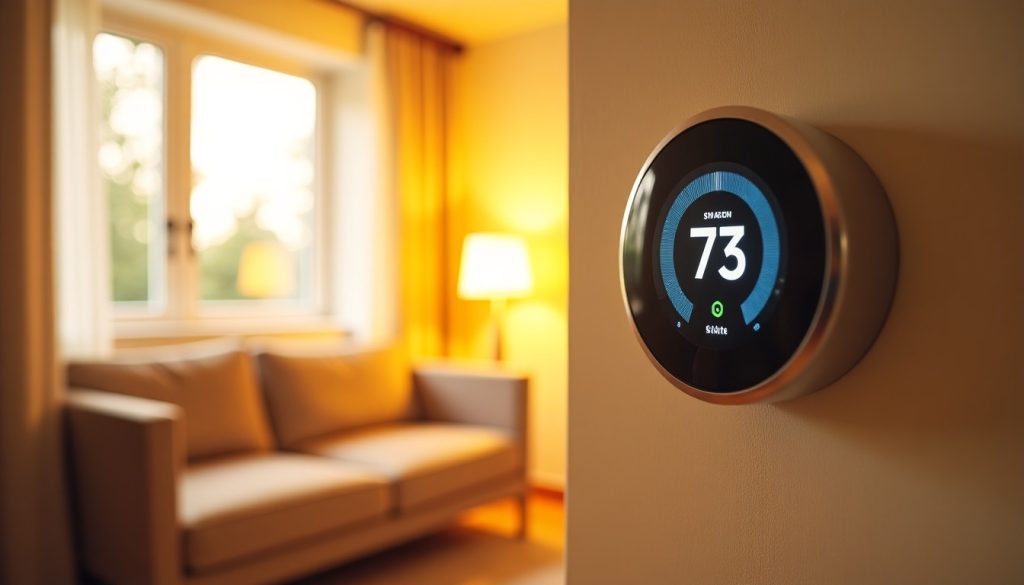Optimizing your home’s heating and cooling systems is an effective way to realize significant cost-cutting on your monthly utility bills. These systems account for a substantial portion of energy consumption in most households, making them prime targets for improvements. By implementing a few strategic changes, you can enhance efficiency, improve performance, and ultimately enjoy energy savings that reflect positively on your wallet.
To start, consider scheduling regular maintenance checks for your HVAC system. A well-maintained system runs more efficiently and extends its lifespan, reducing the need for costly replacements. Ensure that the filters are changed regularly, as dirty filters can restrict airflow, forcing the system to work harder than necessary. This simple home tip can lead to a noticeable difference in energy usage.
Furthermore, it’s essential to examine the insulation in your home. Adequate insulation helps maintain a consistent indoor temperature, minimizing the need for excessive heating or cooling. Check areas like the attic, walls, and floors for insulation gaps and seal any leaks that may compromise energy efficiency.
Programmable thermostats represent another effective strategy for boosting the energy efficiency of heating and cooling systems. These devices allow you to set and maintain optimal temperatures throughout the day, ensuring your system isn’t running unnecessarily. For instance, you can program the thermostat to lower the heat during the night or when you’re away from home, then automatically raise it before you return or wake up.
Investing in a smart thermostat can further enhance these benefits by providing energy usage reports and suggestions for even more efficient operation. Many models also offer the convenience of remote access from your smartphone, ensuring you retain control regardless of where you are.
Additionally, consider upgrading older systems to energy-efficient models. Modern HVAC units often perform better and consume less energy than their older counterparts. When contemplating a new system, pay attention to the Seasonal Energy Efficiency Ratio (SEER) rating; higher ratings imply greater efficiency and potential for savings.
To illustrate the potential savings, consider this comparison:
| Old System SEER Rating | New System SEER Rating | Estimated Annual Savings |
| 10 | 16 | $300 |
| 12 | 18 | $400 |
Beyond these measures, take advantage of passive strategies such as using ceiling fans to circulate air effectively. In the summer, running fans can reduce reliance on air conditioning by making the indoor environment feel cooler. In the winter, reversing the fan direction helps distribute warm air that collects near the ceiling, enhancing the system’s efficiency.
By prioritizing these practical adjustments and upgrades, you can adeptly navigate the balance of maintaining comfort and achieving financial prudence through lowered monthly utility expenses. Implementing these strategic approaches not only contributes to cost-cutting but also supports broader energy savings and sustainability goals. Through diligent attention to your heating and cooling systems, financial relief and enhanced home comfort are well within reach.
Embrace energy-efficient lighting
Switching to energy-efficient lighting is one of the simplest, yet most impactful changes you can make for meaningful cost-cutting on your monthly utility bills. Not only does it result in substantial energy savings, but it also supports a broader sustainability mission by reducing your carbon footprint. Given the significant advancements in lighting technology, there’s never been a better time to make the switch.
To start making these changes, follow these steps:
- Assess Your Current Lighting: Walk through your home and take note of the types of bulbs currently used in each fixture. Traditional incandescent bulbs are energy hogs and should be your first targets.
- Choose LED or CFL Bulbs: Replace incandescent bulbs with LED or CFL (compact fluorescent lamp) bulbs. LEDs are the more energy-efficient option, using up to 75% less energy and lasting up to 25 times longer than incandescent lighting. While CFLs are cheaper upfront than LEDs, their lifespan is shorter, and they contain trace amounts of mercury, which requires careful disposal. Prioritize LEDs where possible for greater long-term savings and convenience.
- Select the Right Bulbs for Your Needs: Not all LED bulbs are created equal. Pay attention to the brightness (measured in lumens) and color temperature (measured in Kelvin) to match your preferences and the ambiance you desire. For cozy atmospheres, opt for warm white (around 2700K), while daylight bulbs (5000K and above) suit workspaces or areas requiring focused task lighting.
- Utilize Dimmers: Install dimmer switches where applicable to adjust lighting levels to your needs throughout the day. This not only enhances comfort but also contributes to energy savings, as lowering the light intensity results in reduced energy consumption.
- Make Use of Natural Light: During the day, make the most of natural light to minimize the need for artificial lighting. Open blinds or curtains to let sunlight in, and consider rearranging furniture to maximize light flow in frequently used spaces.
- Utilize Timers and Sensors: Consider installing motion sensors in less frequently used rooms such as pantries, closets, or garages. These devices turn off lights automatically when no movement is detected, reducing energy use when lights are inadvertently left on. Timers can also be useful for porch or exterior lighting during nighttime hours.
- Educate Household Members: Ensure that everyone in the home understands the impact of turning off lights when leaving a room. Developing simple habits like this can lead to significant energy savings and contribute toward achieving financial thriftiness.
By leveraging these home tips and making conscientious choices in your lighting approach, you can achieve notable reductions in your energy bills. Embracing energy-efficient lighting is an accessible step toward a more sustainable lifestyle, offering both immediate and long-term benefits on the journey to a more energy-conservative household.
Conserve water usage
Reducing your water usage is a crucial step not only for protecting the environment but also for achieving significant cost-cutting on your utility bills. Many homeowners overlook the potential savings that can be gleaned from mindful water consumption, yet simple adjustments and habits can lead to noticeable reductions in monthly expenses. By implementing several strategic home tips, you can decrease water waste and enjoy the financial benefits that come with it.
One effective way to conserve water is to inspect your home for leaks, which can lead to substantial, unnecessary water expenditure. Leaky faucets, toilets, and pipes are common culprits, often going unnoticed yet significantly raising your water bill. Regularly check these fixtures and repair any leaks promptly. A small drip can waste gallons of water, so addressing these issues ensures not only savings but also contributes to longer-lasting plumbing systems.
Installing water-saving fixtures is another practical approach to trim down your water usage. Consider upgrading to low-flow showerheads and faucet aerators, which are designed to minimize water flow without compromising performance. These fixtures can reduce water consumption by up to 30%, representing a noteworthy opportunity to enhance your home’s water efficiency. Similarly, dual-flush toilets provide the option of a half-flush or a full-flush, depending on the need, leading to significant energy savings in terms of water heating and usage.
Adopting smart habits in your daily routines is equally important. For example, turning off the tap while brushing your teeth or lathering your hands can save a remarkable amount of water. Moreover, taking shorter showers instead of long baths, only running the dishwasher and washing machine with full loads, and capturing rainwater for gardening are all valuable strategies for conserving water in your household.
Additionally, consider the benefit of replacing traditional lawn and garden setups with drought-resistant plants and landscaping designs. This helps reduce the need for frequent watering while maintaining an attractive outdoor space. Utilize mulch to retain soil moisture and consider employing drip irrigation systems that provide water directly to the roots, thereby maximizing efficiency and minimizing waste.
By cultivating a conscious approach to water use, you not only achieve cost-cutting advantages but also contribute to sustainable, environmentally friendly practices. These home tips are simple to implement yet powerful in their ability to transform your household’s water consumption, illustrating that long-term financial and environmental benefits are well within reach.
Leverage smart home technologies
In today’s technologically advanced era, smart home technologies offer a substantial opportunity for energy savings, cost-cutting, and convenience. By integrating smart devices into your home, you can effectively monitor and manage your energy consumption, leading to decreased utility bills and a more efficient household. Embracing these technologies can revolutionize the way you interact with your home while promoting a more sustainable lifestyle.
Start by upgrading to a smart thermostat, if you haven’t already, to improve your heating and cooling efficiency. These devices learn your schedule and temperature preferences, automatically adjusting settings to optimize energy use. Some models even offer insights into your energy consumption patterns, allowing you to pinpoint areas for improvement and implement targeted energy-saving strategies. As a bonus, smart thermostats can often be controlled remotely via smartphone apps, ensuring you stay in control even when you’re away from home.
Smart lighting systems also present an excellent opportunity for cost-cutting by enabling you to control your lights remotely, set schedules, and even adjust brightness levels automatically based on the time of day or ambient light levels. With features like motion detection, lights can automatically turn off when a room is unoccupied, eliminating unnecessary energy consumption. By embracing these smart lighting solutions, you can reduce energy waste and see a noticeable drop in your electricity bills.
Consider integrating smart power strips into your home as another savvy home tip. These strips identify and shut down power to devices that are in standby mode but still drawing electricity, commonly known as “phantom” or “vampire” energy. By eliminating this waste, you contribute to meaningful energy savings without sacrificing convenience or accessibility to your devices.
Moreover, appliances equipped with smart technology can further enhance energy efficiency. For instance, smart refrigerators can monitor energy usage and alert you if a door is left open, while smart washers and dryers can adjust cycles based on load size and fabric type to minimize water and energy usage. These smart appliances not only offer advanced functionality but also support a broader mission of reducing overall household energy consumption.
Finally, explore smart home hubs, which allow you to streamline the management of all connected devices within a single platform. Hubs coordinate various smart products, enabling seamless automation of routines that maximize efficiency and comfort. For example, you can program a morning routine where lights gradually brighten, the thermostat adjusts to your preferred temperature, and coffee starts brewing without lifting a finger.
By leveraging these smart home technologies, you stand to gain both in financial terms and in terms of convenience and sustainability. The investment in smart technology is more than justified by the future energy savings and cost reductions on your monthly utility bills. Making use of these innovative solutions represents a significant stride toward a more energy-efficient and economically prudent lifestyle, turning your home into a modern, resource-efficient haven.
Reduce appliance energy consumption
Reducing appliance energy consumption is an essential component of any effective strategy aimed at achieving substantial cost-cutting on monthly utility bills. Appliances account for a significant portion of household energy use, so optimizing their efficiency can lead to impressive savings. Start by conducting an audit of the appliances in your home, paying particular attention to older models that may not be as energy efficient as their newer counterparts. Replacing outdated appliances with ENERGY STAR-rated models can result in considerable energy savings while also enhancing the functionality and longevity of your appliances. This is especially true for major appliances such as refrigerators, dishwashers, and clothes washers, which run frequently and consume substantial energy.
For existing appliances, implementing simple yet effective home tips can further reduce energy consumption. Begin with the refrigerator, one of the most energy-hungry appliances in any home. Ensure it is running efficiently by setting it to the optimal temperature: 37-40 degrees Fahrenheit for the fridge compartment and 0-5 degrees Fahrenheit for the freezer. Regularly defrost manual-defrost freezers to maintain efficiency, and keep the coils clean to ensure proper ventilation and cooling.
When it comes to dishwashers and clothes washers, maximize efficiency by only running full loads, as these machines use roughly the same amount of energy regardless of load size. Select energy-saving settings or use cold water cycles whenever possible, particularly for clothes washing, as heating water consumes a significant amount of energy. Take advantage of air-drying dishes and laundry when feasible to cut down on energy used by heat-dry settings or electric dryers.
Consider reorganizing your kitchen layout as well—placing the fridge away from heat sources like ovens or direct sunlight will prevent it from working harder to maintain its internal temperature. In the case of ovens and stovetops, reduce energy use by matching pot sizes to burners and utilizing lids to accelerate cooking. Utilizing smaller appliances like microwaves or toaster ovens for smaller meals can also contribute to overall energy savings.
Additionally, be mindful of vampire energy, which occurs when appliances and electronics draw power even when turned off or in standby mode. Unplugging devices, using power strips, or integrating smart plugs can make it simpler to ensure that unused appliances aren’t needlessly consuming energy.
Incorporating these practical home tips into your daily routine can significantly reduce your household’s energy footprint while supporting your financial goals. With thoughtful planning and conscientious habits, you can enjoy the dual benefits of energy savings and enhanced appliance performance, further contributing to a cost-efficient and eco-friendly home environment.
In conclusion, effectively lowering your monthly utility bills is achievable through a combination of practical strategies and smart investments. By optimizing heating and cooling systems, adopting energy-efficient lighting, conserving water, leveraging technology, and reducing appliance energy consumption, you not only save money but also embrace a more sustainable lifestyle. These thoughtful changes contribute to long-term financial and environmental benefits, turning your home into an efficient and eco-friendly haven.





